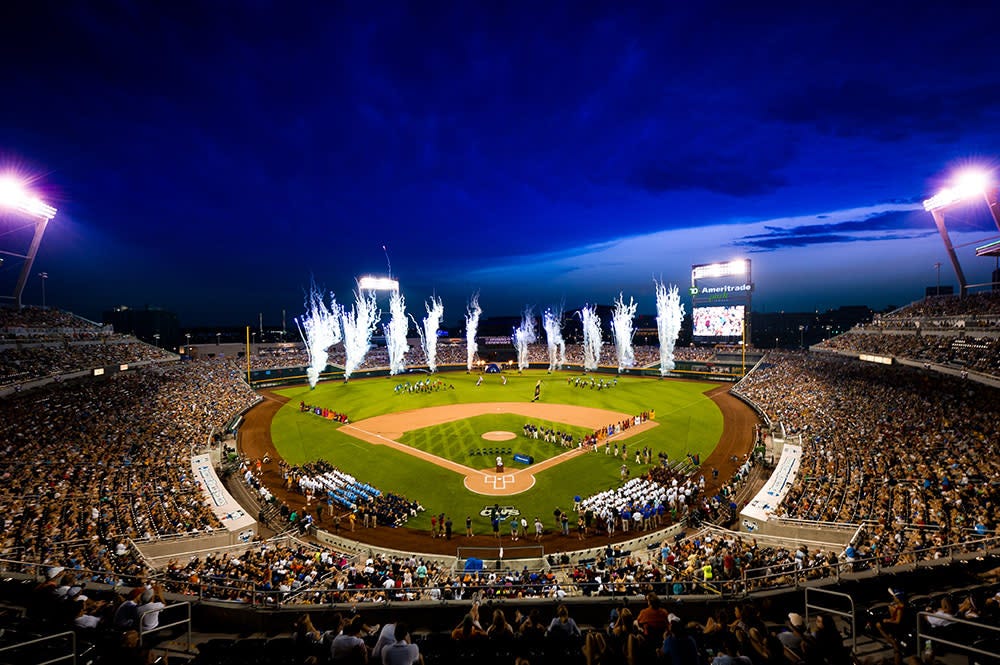How Omaha and the Men's College World Series came to form one of college sports' happiest marriages
College baseball's preeminent event has been held in the same city since 1950. How that came to be and the impact it has had on the city it has become synonymous with
Last week, eight college baseball teams traveled to the middle of the country for a potentially life-changing trip. If LSU, Florida, Virginia, Wake Forest, Stanford, Tennessee, TCU or Oral Roberts got enough timely hits and solid pitching performances, they could live forever as champions.
The Men’s College World Series is the grand stage on which Division I college baseball crowns its champion annually, but for the octet of teams and their fans who ventured to see them live, the trophy for which they’re all vying is only a part of what awaits them. The MCWS isn’t merely a collection of games to decide who the sport’s best team is after a long, trying season. It’s equal parts pageant, festival and celebration, with fans bouncing around beach balls inside the stadium and downing Jell-O shots in dizzying succession outside of it, with the local community wholeheartedly embracing them throughout.
That community is what we’re going to focus on today.
For every year but one dating back to 1950, the MCWS has been held in Omaha, Neb., with only a once-in-a-generation global pandemic preventing it from taking place. Among the highest-profile championships in college sports, it holds a unique place. Unlike the College Football Playoff title game, which has been in nine different places in its nine-year history, or the men’s basketball Final Four, which has been in six different cities over the past six tournaments, the MCWS is affixed to a single location.
It’s an oddity, to be sure, one that perhaps limits the profitability and exposure of the event. But that’s what makes these two weeks in June worth cherishing – and it’s why, after all these years, it still carries a certain aura.
How did this marriage come to be?
As synonymous as the MCWS and Omaha are with one another, and have been for decades, the event didn’t actually begin there.
In its first two years of existence, the MCWS – an MLB trademark licensed to the NCAA for annual use – took place in Kalamazoo, Mich. In its third year, in 1949, it was held in Wichita, Kan.
Even as the MCWS was being played elsewhere, the groundwork for its future and permanent home was being put into place.
Johnny Rosenblatt had grown up as a standout baseball player in Omaha, earning a scholarship to play at Iowa before he had to leave the university to help financially support his family. He played semi-pro ball for several years before landing a job as a dairy salesman. Eventually, though, he found his way into politics, winning a seat on Omaha’s city council and later becoming mayor.
In the early 1940s, Rosenblatt linked up with a group of local businessmen and civic leaders like Ed Pettis and Morris Jacobs to push for the construction of a new ballpark in Omaha. While its primary purpose would be to host a minor-league baseball franchise the city desired – and which they quickly got with the Omaha Cardinals – Rosenblatt and the men who came to be known as “the Founding Fathers” had other, bigger plans in mind. They envisioned it being a home for college and professional football exhibition games, as well as major events that previously wouldn’t have considered Omaha to be a suitable home.
In the MCWS, they identified a target for their vision. With Omaha Municipal Stadium completed in 1948, Rosenblatt, Pettis and Jacobs ventured down to Wichita for the 1949 MCWS. Together, and with a new stadium to sell, the trio pitched NCAA officials on the merits of Omaha for a tournament that was still in its infancy and had yet to find anything resembling a permanent home.
It worked. The following year, the MCWS made its way to Omaha and has never left.
Keep reading with a 7-day free trial
Subscribe to The Front Porch to keep reading this post and get 7 days of free access to the full post archives.




